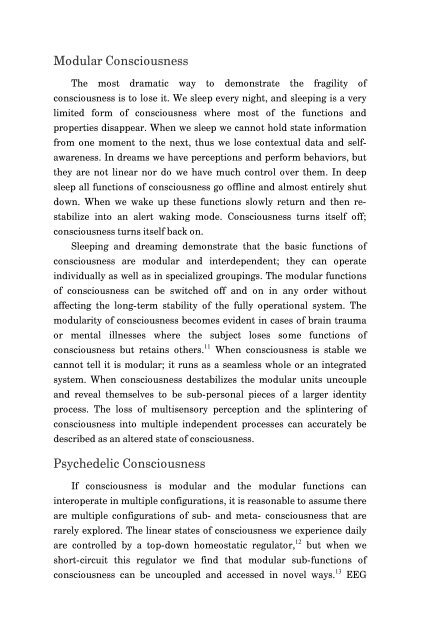Psychedelic-information-theory-Shamanism-in-the-age-of-Reason
Psychedelic-information-theory-Shamanism-in-the-age-of-Reason
Psychedelic-information-theory-Shamanism-in-the-age-of-Reason
- No tags were found...
Create successful ePaper yourself
Turn your PDF publications into a flip-book with our unique Google optimized e-Paper software.
Modular ConsciousnessThe most dramatic way to demonstrate <strong>the</strong> fragility <strong>of</strong>consciousness is to lose it. We sleep every night, and sleep<strong>in</strong>g is a verylimited form <strong>of</strong> consciousness where most <strong>of</strong> <strong>the</strong> functions andproperties disappear. When we sleep we cannot hold state <strong><strong>in</strong>formation</strong>from one moment to <strong>the</strong> next, thus we lose contextual data and selfawareness.In dreams we have perceptions and perform behaviors, but<strong>the</strong>y are not l<strong>in</strong>ear nor do we have much control over <strong>the</strong>m. In deepsleep all functions <strong>of</strong> consciousness go <strong>of</strong>fl<strong>in</strong>e and almost entirely shutdown. When we wake up <strong>the</strong>se functions slowly return and <strong>the</strong>n restabilize<strong>in</strong>to an alert wak<strong>in</strong>g mode. Consciousness turns itself <strong>of</strong>f;consciousness turns itself back on.Sleep<strong>in</strong>g and dream<strong>in</strong>g demonstrate that <strong>the</strong> basic functions <strong>of</strong>consciousness are modular and <strong>in</strong>terdependent; <strong>the</strong>y can operate<strong>in</strong>dividually as well as <strong>in</strong> specialized group<strong>in</strong>gs. The modular functions<strong>of</strong> consciousness can be switched <strong>of</strong>f and on <strong>in</strong> any order withoutaffect<strong>in</strong>g <strong>the</strong> long-term stability <strong>of</strong> <strong>the</strong> fully operational system. Themodularity <strong>of</strong> consciousness becomes evident <strong>in</strong> cases <strong>of</strong> bra<strong>in</strong> traumaor mental illnesses where <strong>the</strong> subject loses some functions <strong>of</strong>consciousness but reta<strong>in</strong>s o<strong>the</strong>rs. 11 When consciousness is stable wecannot tell it is modular; it runs as a seamless whole or an <strong>in</strong>tegratedsystem. When consciousness destabilizes <strong>the</strong> modular units uncoupleand reveal <strong>the</strong>mselves to be sub-personal pieces <strong>of</strong> a larger identityprocess. The loss <strong>of</strong> multisensory perception and <strong>the</strong> spl<strong>in</strong>ter<strong>in</strong>g <strong>of</strong>consciousness <strong>in</strong>to multiple <strong>in</strong>dependent processes can accurately bedescribed as an altered state <strong>of</strong> consciousness.<strong>Psychedelic</strong> ConsciousnessIf consciousness is modular and <strong>the</strong> modular functions can<strong>in</strong>teroperate <strong>in</strong> multiple configurations, it is reasonable to assume <strong>the</strong>reare multiple configurations <strong>of</strong> sub- and meta- consciousness that arerarely explored. The l<strong>in</strong>ear states <strong>of</strong> consciousness we experience dailyare controlled by a top-down homeostatic regulator, 12 but when weshort-circuit this regulator we f<strong>in</strong>d that modular sub-functions <strong>of</strong>consciousness can be uncoupled and accessed <strong>in</strong> novel ways. 13 EEG


